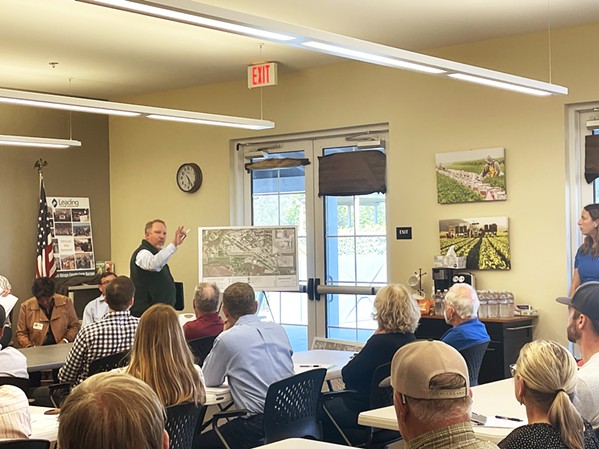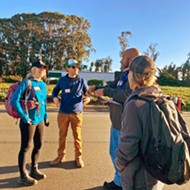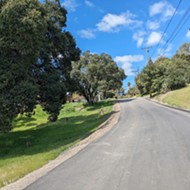Pressing pollution: Residents near the SLO airport with PFAS-contaminated wells ask for "full replacement" of water
By Camillia Lanham[{
"name": "Newsletter Promo",
"id": "NewsletterPromo",
"class": "inlineCenter",
"insertPoint": "4",
"component": "15264767",
"requiredCountToDisplay": "0"
},{
"name": "Ad - Medium Rectangle CC01 - 300x250",
"id": "AdMediumRectangleCC01300x250",
"class": "inlineCenter",
"insertPoint": "8",
"component": "2963441",
"requiredCountToDisplay": "12"
},{
"name": "Ad - Medium Rectangle LC01 - 300x250",
"id": "AdMediumRectangleCC01300x250",
"class": "inlineCenter",
"insertPoint": "18",
"component": "2963441",
"requiredCountToDisplay": "22"
},{
"name": "Ad - Medium Rectangle LC09 - 300x250",
"id": "AdMediumRectangleLC09300x250",
"class": "inlineCenter",
"insertPoint": "28",
"component": "3252660",
"requiredCountToDisplay": "32"
}]
For more than 20 years, Marge Barinka has lived off Buckley Road in San Luis Obispo, using the groundwater beneath her property for livestock, gardening, and living.
But the well she's relied on for so long is polluted with chemicals known as PFAS (per- and polyfluoroalkyl substances) at levels that exceed drinking water standards, according to tests conducted in March/April of 2023.
"Apparently, we have all been exposed to these 'forever chemicals' for decades without our knowledge. We use our well water for drinking, cooking, bathing, cleaning, and irrigation of fruits and vegetables," Barinka told the Central Coast Regional Water Quality Control Board on June 23. "We demand that the responsible parties provide full replacement water to all of the PFAS-affected private property owners."
Barinka is one of dozens of property owners near the SLO County Regional Airport who have found out in the last year that their wells are contaminated with PFAS. State regulators say that the pollution stems from firefighter trainings held annually at the airport since the mid-1970s, where a PFAS-rich foam called aqueous film forming foam (AFFF) was discharged into the environment. When ingested at high levels, PFAS is believed to increase the risk of kidney cancer, birth defects, and other health issues.
In 2019, the State Water Resources Control Board ordered 30 airports statewide to investigate the presence of PFAS in groundwater and soil. In addition to testing at the SLO airport, which was found to have some of the highest PFAS concentrations in the state, SLO County-contracted consulting company Roux also sampled private wells in proximity to the airport.
As of a Feb. 28, 2023, report that Roux submitted to the regional water board, the company had sampled 57 wells. Up to 52 of those wells contain "concentrations of PFAS above drinking water response levels," water board staff said. In other words, those wells contain levels that regulatory agencies like the U.S. Environmental Protection Agency (EPA) don't consider safe to drink.
More testing has been conducted since February, according to residents who spoke at the June 23 water board listening session, expressing their frustration with the well-testing process, a lack of communication, and what they feel is a general disregard for their health and safety. At the listening session, residents found out that a tentative voluntary cleanup settlement agreement was reached between the county, Cal Fire, and the water board. However, it wasn't released to the public until June 26, which upset resident Mike Oliveira, who felt blindsided by the news.
"The voluntary agreement that's been mentioned so far has been, as it is, negotiated behind closed doors. We are anxious to see it," Oliveira told the board, adding that he wished more had been done to formally include the concerns of impacted homeowners. "The deals that have happened in the years since this started have left people feeling left out of the process."
He asked the board what the plan for further testing is and pointed out that he disagreed with the county's assessment of where the PFAS contamination could stem from at the airport. The county's investigation concludes that the area where the current Cal Fire station sits is where the majority of trainings involving AFFF took place—and the report also states that there are numerous other potential sources of PFAS contamination in the area, outside of the airport.
But Oliveira pointed to where the three properties with the highest concentrations of PFAS are: directly across from a runway where he and other longtime residents said they witnessed yearly firefighting trainings.
"It's not characterized correctly," Oliveira said.
If consultants had spoken with residents who have lived in the area for decades, he said, they would have known about those trainings.
Kathy Borland owns one of the homes directly across from the runway in question, and her well has some of the highest concentrations of PFAS in the area. A culvert diverts stormwater run-off from the airport, under Buckley Road, and deposits it directly onto one side of her property. She's lived there since 1983 and said she saw many firefighter trainings take place across the street from her house over the years.
Since 2015, Borland's fought for clean water. That was when she first learned that TCE—another toxic chemical—polluted her groundwater. Her property is one of 11 in the area that tested positive for undrinkable levels of TCE several years ago and also recently tested positive for undrinkable levels of PFAS.
The saga has been a long one, she said, adding that she and others who went through the TCE testing and "cleanup" process with the water board don't trust that the government will do what's best for residents.
Although Borland has a carbon filter for the water going into her house due to the TCE contamination, she paid for it herself ($5,000). She's advocating for the county and/or Cal Fire to install carbon filters at the wellheads of every property impacted by PFAS contamination. That, she said, would be full replacement of contaminated water.
"The bottom line is they need to take care of the residents in this neighborhood," Borland told New Times. "They need to give us clean water."
The settlement agreement stipulates exactly how and under what timeline the "responsible" parties—the county and Cal Fire—will cleanup the pollution, starting with providing residents who have contaminated groundwater a reverse-osmosis filter for their drinking water. However, Borland and Oliveira say the agreement is hard to understand because it uses a lot of legalese. They're hoping to get a better idea of exactly what it says before the July 11 deadline for public comments.
On July 21, the regional water board will decide the agreement's fate, taking public comment into consideration, staff told residents at the listening session.
Third District SLO County Supervisor Dawn Ortiz-Legg told New Times that she believes the settlement agreement gives residents what they're asking for.
"I'm really happy that we've been able to come to a tentative agreement," Ortiz-Legg said, adding that the county wants to ensure that residents have access to clean water. "There's so many unknowns, so it's challenging to figure out how to manage this."
PFAS regulations are a work in progress. The EPA is still hammering out its official recommendation for what's considered to be safe levels of PFAS in drinking water supplies. In March 2023, the agency released proposed drinking water regulations for some PFAS chemicals. Although the public comment period ended in May, the EPA hasn't finalized the regulations yet.
Regardless, Oliveira said that the county has known since at least 2019 that residents could have PFAS-contaminated water and should have done a better job of outreach to local property owners. He added that many residents have "water contamination fatigue" due to the years of battling the water board over TCE pollution and may not be paying as close attention as they should to the PFAS investigations.
"It's been private property owners knocking on the door of the county supervisor's office, environmental health, and public health that's gotten us the information that we have so far," Oliveira told the water board. "The process, as it's been rolled out, from the public's view, hasn't had enough of the public involved in it early on." Δ
Reach Editor Camillia Lanham at [email protected].
Latest in News
Readers also liked…
-

Coast Unified teachers upset over new position's salary and qualifications
Oct 20, 2022 -

SLO police identify alleged driver who hit and killed couple
Dec 22, 2022 -

When the levee breaks: Oceano residents, county officials walk a tightrope of regulations to manage Arroyo Grande Creek, which some say led to the levee's failure in January
May 18, 2023










